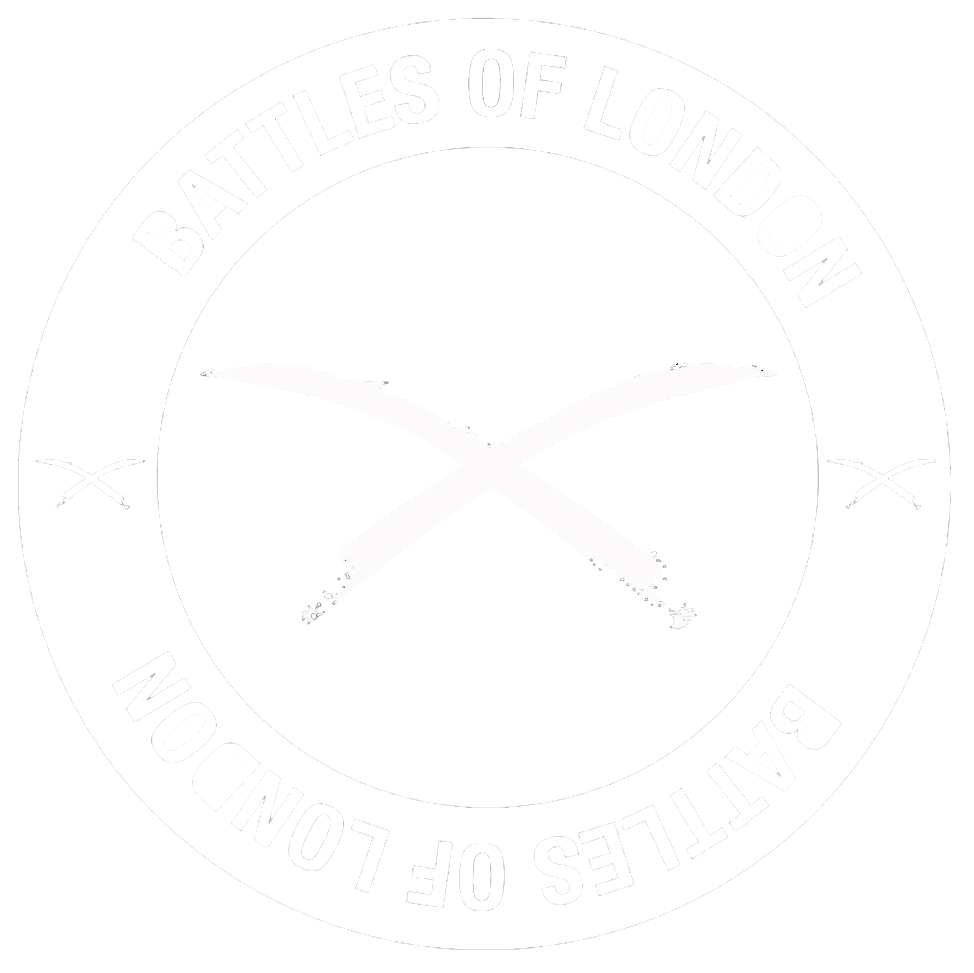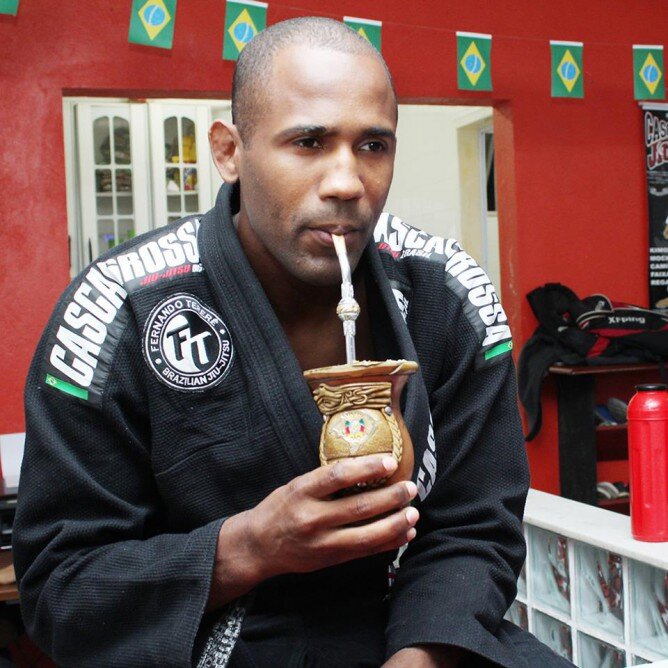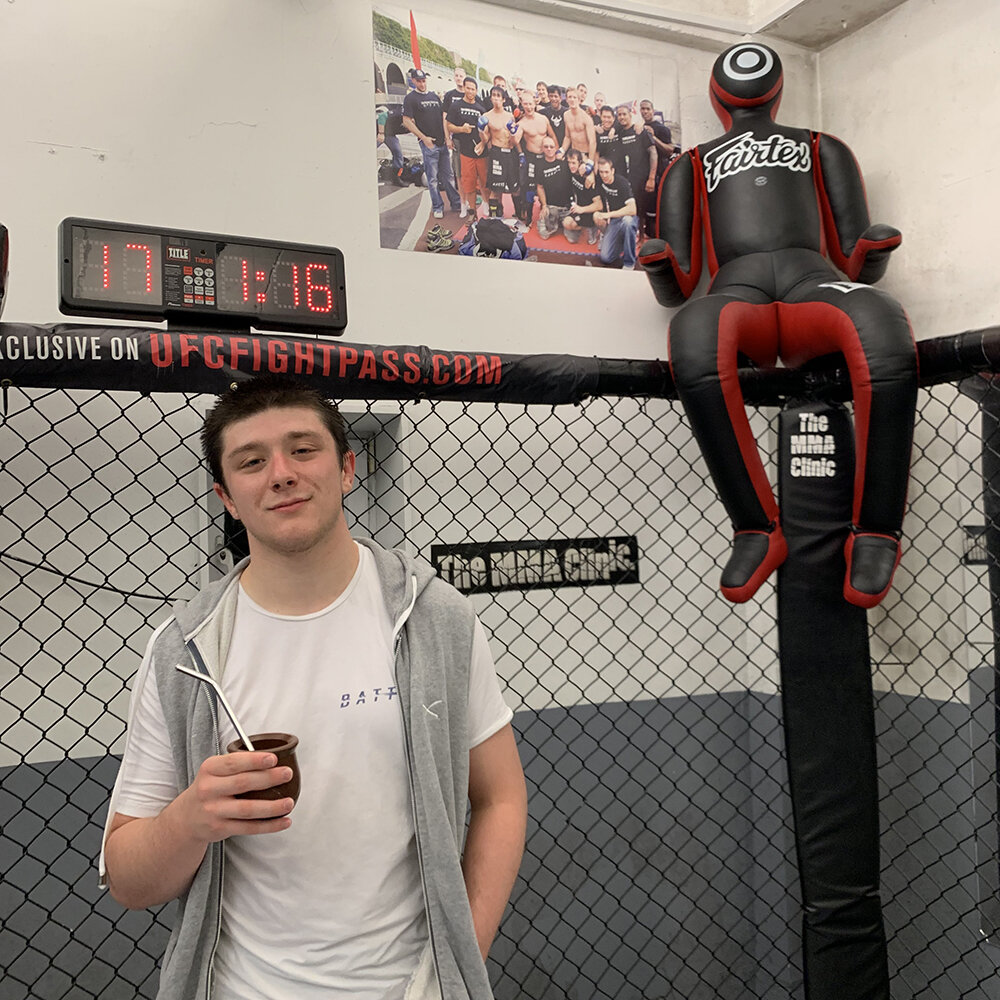Special Brew
‘The Jimmy Hendrix of Jiu Jitsu’ Fernando Augusto da Silva gets stuck into his gourd of Yerba Mate. Photo by Hywel Teague.
Yerba mate is the hot drink of choice for the BJJ crowd, promising ‘coffee without the crash’. Battles’ Andrei Vitaliev switched his coffee for it, and this is what happened.
MMA fighters like Fabricio Werdum, jiu jitsu champions including Roberto Cyborg Abreu, celebrities, soccer superstars and even Barack Obama drink it. A caffeine boost that lasts a day - ‘crashless coffee’ that I’d been told would improve my focus and metabolism. After all the athlete endorsements and gossip I’d heard, I wanted some Yerba Mate for myself.
Like anyone who follows the fight community, for months I'd been hearing whispers about the elusive, traditional South American herbal tea. Mate, pronounced mah-teh, is a tea developed from the Yerba Mate plant, largely grown in Brazil and Argentina. My method of staying awake between my nine to five and training was simple: guzzling down countless cups of coffee to stay buzzed, then trying to avoid an energy dump when the caffeine wore off and finding myself horrendously more tired than before. Between my seventh (or maybe eighth) shot of coffee one particularly nasty Wednesday after a late night, I found myself wondering… what if the hype is true? Is Yerba a healthy way to increase focus and stay energised?
Eager to find out, I set myself a test. For one week I would completely cut coffee out of my life and replace it entirely with Mate tea.
Andrei sneaks in a cheeky gourd at the gym
Acquiring the tea was easy enough, in the UK, it’s stocked at most of the larger organic food stores, including Holland and Barrett and Whole Foods. Mate is traditionally drank from a short cup called a ‘gourd’, and a filtered metal straw known as a ‘bombilla’. While the tea can still be drank with a normal filter, I wanted the authentic experience.
Unfortunately, so far as I could tell, the only way to acquire this ‘authentic’ experience was to buy the kit online. After my gourd and bombilla arrived, I prepared my first batch of Mate at work the next morning with excitement. Placing the bombilla into my mouth, I was hit by the earthy, bitter and slightly sour taste of the beverage.
I did not instantly like it, to be honest.The flavour wasn’t nearly as immediately tasty as coffee. However, a few minutes later I felt a boost unlike anything I’d experienced before..
Not only did I feel less tired, but I felt more alert, sharper and more ‘on point’. Perhaps I have a low tolerance, because the effects lasted for over five hours on me. Amazed, and ready to see if I could utilise the effects of Yerba Mate during training, I sipped another gourd beforehand. I felt more focused when listening to instruction, clear minded during sparring, and less exhausted afterwards.
Ornamental Yerba Mate gourd
Over the next six days I consumed two gourds of Yerba Mate every 24 hours; except on the third day. Overestimating my caffeine threshold, I found myself with a strong case of jitters and shaking hands after slugging three gourds down. Nonetheless, over the other six days I found myself clearer minded:more composed at work, more thoughtful and strategic on the mats and generally more relaxed – as well as feeling substantially more energetic. After a few days I even found myself craving the flavour of Yerba!
Yerba Mate tea seemed like the perfect beverage for the first few days of my experiment. However, as time went on, I started to have a couple of issues.
The first was with the gourd. While I must admit that it looked awesome (and the attention I got from drinking out of it didn’t go unappreciated either) it’s not ideal for anyone on the move. On several occasions in the rush to get from work to the gym, I found myself trying to take Mate with me only to end up with most of my drink spilled, either muddying the floor or scalding my hands. And while I was enjoying Mate’s flavour, I still missed lattes.
However, while all of these are slightly trivial criticisms of what I found to be a great supplement to my training, I stumbled across a much larger problem after asking a nutritionist friend why Yerba hasn’t taken off much in Europe. Cancer.
In particular, mouth, lung and esophageal cancer. Studies such as Stefani et. al (2011) write ‘Odds ratios for mate consumption were directly associated with cancers of the upper aerodigestive tract (UADT), esophagus, stomach, larynx, lung, cervix uteri, prostate, bladder, and kidney.’ Potentially shortening one’s life for an enhanced caffeine buzz is simply not worth it.
At the end of the week I found myself feeling less tired and increasingly focused. Yerba Mate is a great drink if consumed, like all good things in life, in moderation.
Above all, I feel more interested in exploring various energy supplements besides coffee. Upon further research, the carcinogenic elements of Yerba Mate may potentially be nullified if drank cold, in a drink called tereré. Additionally my nutritionist friend aware of the potentially carcinogenic effects of Yerba Mate, recommended magnesium supplements for energy and recovery instead of any caffeinated beverages.
While the ‘crashless coffee’ might not be a mainstay in my diet going forward, I’m glad that after my week away from coffee I’m now able to appreciate the benefits of different energy supplements. I look forward to continuing to strive for the perfect supplement, or supplements to make me the best martial artist I can be.
Editorial note: this article is only intended to convey one reporter’s experience of Yerba Mate. Obviously consult your GP if you require further details on any aspects of this piece.



